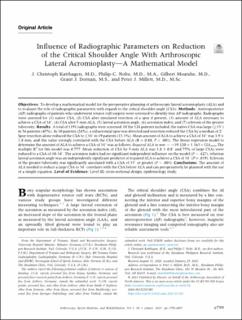Influence of radiographic parameters on reduction of the critical shoulder angle with arthroscopic lateral acromioplasty: A mathematical model
Peer reviewed, Journal article
Published version
Permanent lenke
https://hdl.handle.net/11250/2986921Utgivelsesdato
2021Metadata
Vis full innførselSamlinger
- Artikler / Articles [2096]
- Publikasjoner fra Cristin [1084]
Originalversjon
Arthroscopy, Sports Medicine, and Rehabilitation. 2021, 3(3), Side e799-e805. 10.1016/j.asmr.2021.01.021Sammendrag
Objectives: To develop a mathematical model for the preoperative planning of arthroscopic lateral acromioplasty (ALA) and to evaluate the role of radiographic parameters with regards to the critical shoulder angle (CSA).
Methods: Anteroposterior (AP) radiographs of patients who underwent rotator cuff surgery were screened to identify true AP radiographs. Radiographs were assessed for (1) native CSA, (2) CSA after simulated resection of a spur if present, (3) amount of ALA necessary to achieve a CSA of 34°, (4) CSA after 5-mm ALA, (5) lateral acromion angle, (6) acromion index, and (7) sclerosis of the greater tuberosity.
Results: A total of 1191 radiographs were screened. Of the 124 patients included, the native CSA was large (≥35°) in 56 patients (45%). In 30 patients (24%), a subacromial spur was detected and resection reduced the CSA by a median of 2°. Spur resection alone reduced the CSA to ≤34° in 19 patients (15.3%). Mean amount of ALA to achieve a CSA of 34° was 3.9 ± 1.8 mm, and this value strongly correlated with the CSA before ALA (R = 0.88, P < .001). The linear regression model to determine the amount of ALA to achieve a CSA of 34° was as follows: The multiple R2 for this model was 0.777. Mean reduction of CSA by 5-mm ALA was 3.8 ± 0.8° and 75% of large CSAs were reduced to a CSA of 30-34°. The acromion index had no significant independent influence on the model (P = .427), whereas lateral acromion angle was an independently significant predictor of required ALA to achieve a CSA of 34° (P = .019). Sclerosis of the greater tuberosity was significantly associated with a CSA of 35° or greater (P = .003).
Conclusions: The amount of ALA needed to reduce a large CSA to 34° correlates with the CSA before ALA and can preoperatively be planned with the use of a simple equation.
Level of Evidence: Level III; cross-sectional design; epidemiology study.
Beskrivelse
This is an open access article under the CC BY-NC-ND license (http://creativecommons.org/licenses/by-nc-nd/4.0/).
